Working on a tabletop in her Provincetown studio, Sylvia Tomayko-Peters drags a layer of mint green ink across the surface of the silkscreen she’s using to print a series of holiday cards. She works methodically, quickly filling up the top layer of a drying rack at the end of the table. This one, titled Merry and Bright, begins with the image of a wreath. She’ll return to it in a day or so to layer an image of gold candles atop the wreath.
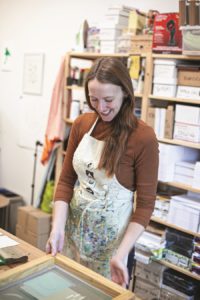
It’s a busy time of year for Tomayko-Peters. As the owner and sole employee of Middle Dune, a stationery and paper goods business, she is preparing cards to sell at the Canteen Holiday Market in Provincetown. She also sells her cards and notebooks at about 100 gift shops and bookstores around the country, including locally at the Provincetown General Store, Chequessett Chocolate in Truro, and Sea Howl Bookshop in Orleans.
She is the daughter of artists Vicky Tomayko and Jim Peters. “My mom’s a printmaker,” says Tomayko-Peters. “Pretty much everything I know I picked up from her.” Making things is “just something I’ve always been immersed in.” Some of the first cards she made were collaborative family creations.
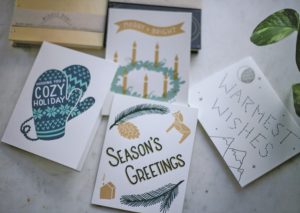
Yet her current life isn’t something that she envisioned for herself. At Brown University, she focused on digital art and writing. Then, after graduation, she realized “I need to go back to working with my hands.” She got a start in that direction at Albertine Press, a letterpress studio in Cambridge. But when she began selling handbound journals on Etsy, the project took off, she says, and she has continued to develop her business over the past six years.
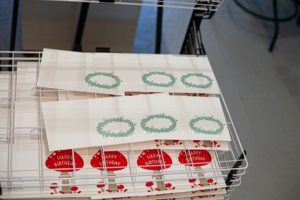
Today, she runs Middle Dune out of the Provincetown living and work space she shares with her husband, Brian Drake, a video game designer. The two met in middle school at the Lighthouse Charter School. They moved back to the Cape from Somerville in 2020 after being picked in a lottery for an affordable artist housing unit.
“I realized how lucky I was to grow up here,” says Tomayko-Peters. “It turned out we’re not city people, and we were ready to get out of Boston and come back. It just clicked when I saw there was an open lottery.”
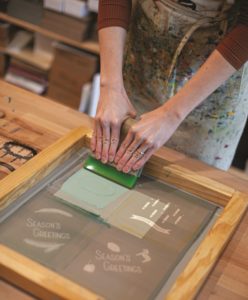
Tomayko-Peters has found her re-immersion in the Outer Cape landscape inspirational. A warren of rabbits she’d been observing in her back yard recently found their way into her imagery. But when she’s approaching holiday card design, she turns to her collection of vintage examples.
“I like to think I’m using traditional images in a more modern and graphic way,” says Tomayko-Peters. “I want to create a message with both the design and text that feels welcoming and cozy and happy,” she adds.
For those interested in making their own cards, Tomayko-Peters suggests collage or making a stamp from a potato or eraser. “I’m a big proponent of using whatever you have,” she says.
Farther up Cape, Carol Rizzoli does just that.
During the cold, rainy spring of 2020, Rizzoli started visiting her husband Hugo’s studio in the barn behind their house, where he works with mixed media. There, “my eye caught a flash of color and texture in the overflowing trash bin,” she says. Taking a closer look, she began pulling out fragments of painted paper, canvas, wood, and even sandpaper and painter’s rags.
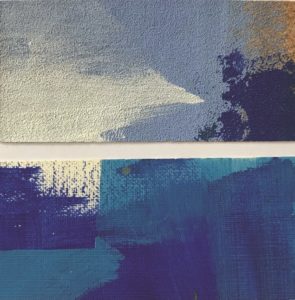
Rizzoli soon found herself editing, clipping, and rearranging these scraps on clean sheets of paper. She brings the discarded materials together in handsome abstract collages that combine textures, colors, and shapes in compositions that often feel harmonious despite their disparate sources.
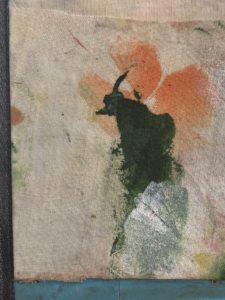
Working a few pieces at a time, “they almost seem to take on a life of their own — when I let them,” Rizzoli says.
She is a writer (including writing about food in the Independent) but after so much working with words she found the creative process of making cards as rewarding as the giving itself. “I’ll never go back to sending a manufactured greeting,” Rizzoli says.
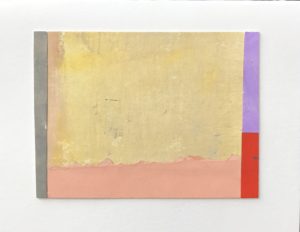
“I started out by sending a card to a close family member,” Rizzoli says. The note was simple, just something she wanted to share during peak pandemic isolation. She continued, sending cards at holidays and people’s birthdays and just to be in touch.
“I got an amazing response,” she says. “That encouraged me to offer them more widely.” This year, Rizzoli is selling cards at the Cape Cod Museum of Art and the Cultural Center of Cape Cod.
Rizzoli made a card recently for her brother who came to Barnstable for a visit. The two had not seen each other for over two years. “I wanted to communicate how much that meant to me,” says Rizzoli. Sitting down to make him a card, she chose a brown base and combined it with “a torn piece of canvas with this beautiful blue paint, which evoked the bay.”
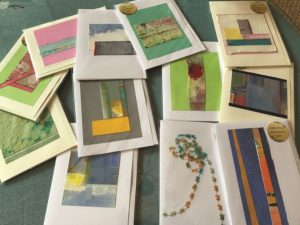
So much of our communication is through text messaging and email, says Rizzoli. There’s something good about the way giving a card “slows down the exchange.”
Tomayko-Peters agrees that card-giving is a thoughtful act. “When we buy things for people we often buy the things we like,” she says. A card prompts us to think more about the person we’re giving it to and ask ourselves, “What is the sentiment they would appreciate?”
